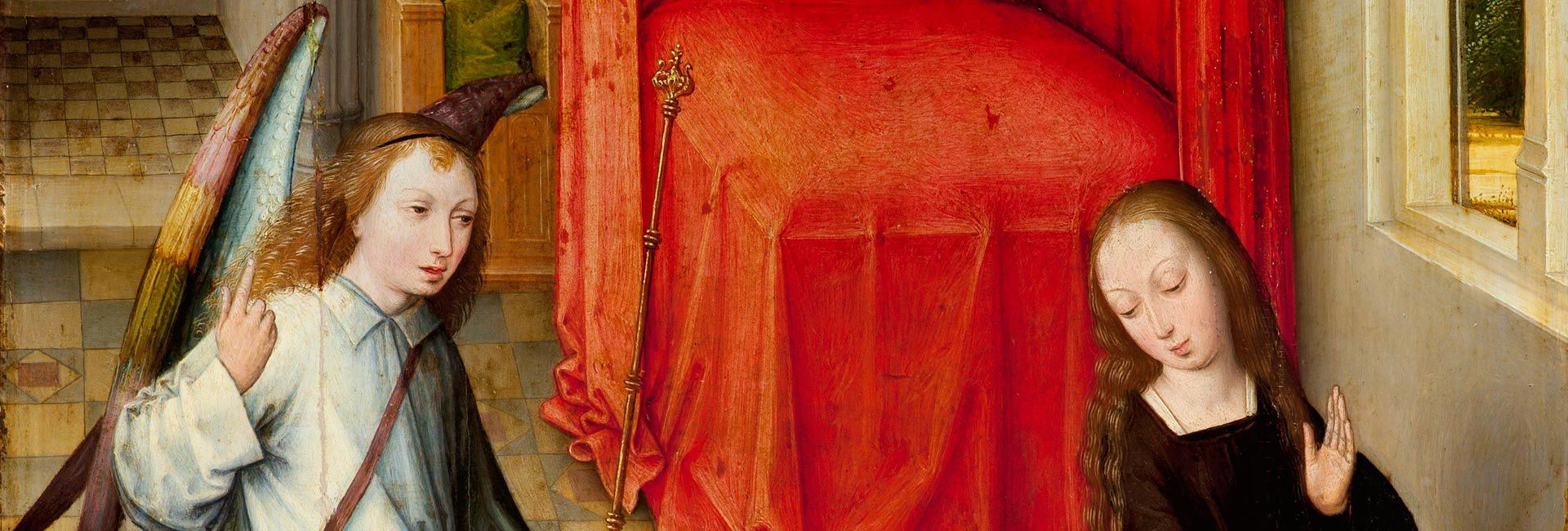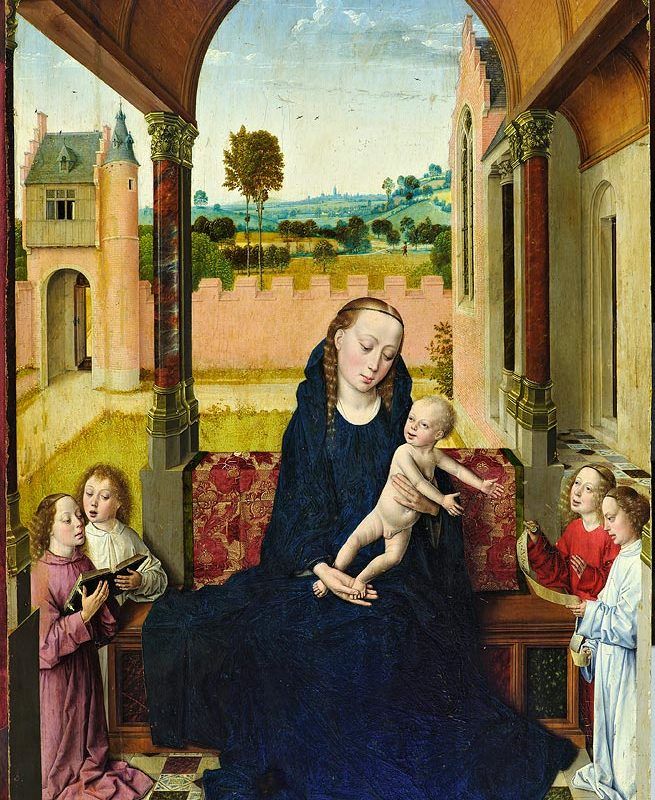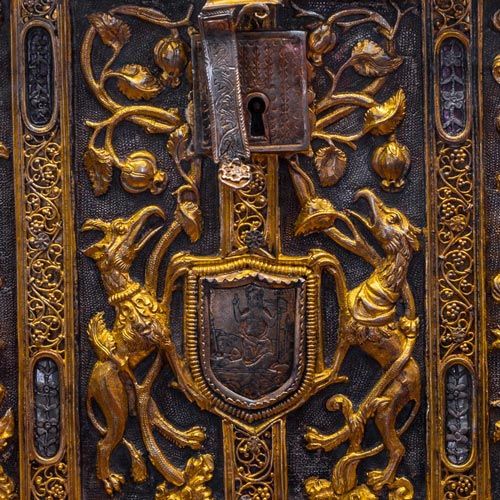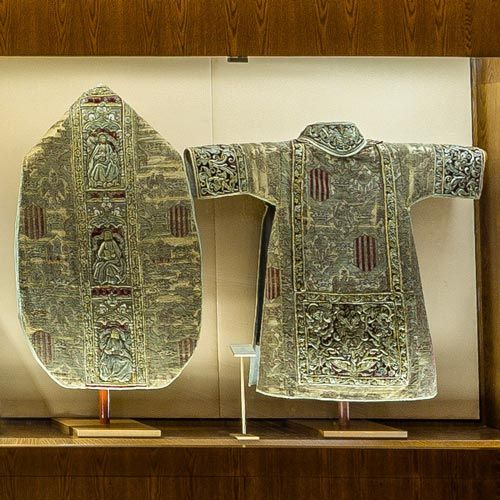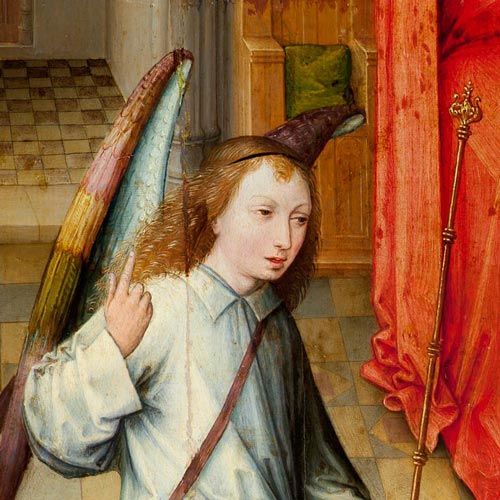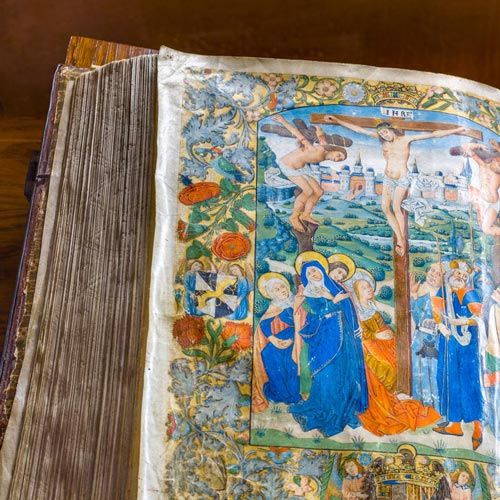The existence of Flemish paintings in the Royal Chapel is due to the will of the Catholic Queen Isabella; in her will she expressed her desire that the paintings be taken from her collection and moved to Granada as an ornament for the Chapel. Her grandson Charles would fulfil her will. Following a chronological order of the works, the painters represented are: Rogier Van der Weyden (1339?-1464), Master of the Legend of St. Catherine (¿Pieter van der Weyden?, active in Brussels during the last quarter of the XV century), Dieric Bouts (c. 1420-1475), Hans Memling (c. 1435-1494), among other painters and anonymous authors.
ROGIER VAN DER WEYDEN
The Altarpiece of the Virgin was originally made of three wood panels. The two first –the Nativity and the Descent from the Cross- are kept in the Royal Chapel. The paintings are oil on a 50.2×37 cm oak wood panel. The main subject of this painting is the glorification of Mary, as emerges from the text of the Magnificant which trims the edge of her cloak. The scenes are presented under a portico which, with its vault, gives depth to the composition. The architectural frame is completed with sculptural decoration.
The Nativity or the Adoration of the Child Jesus by his parents shows the Virgin sitting on the floor, dressed in white, with the Baby asleep in her lap and with her hands together pointing at her Son. On the right, a little out-of-the-way, St. Joseph, portrayed as an old man, is falling asleep leaning on a crook; he is dressed in red with his head covered by a black hood falling down onto his shoulders. The three characters are highlighted with a rich hanging that closes the central background of the composition.
In the Descent from the Cross the interest is focused on a group made up of the Virgin in intense blue, with her eyes red, hugging the rigid body of her dead Son, in which His luminous lightness contrasts with the dark cloak of His Mother. On either side, St. John, in red and with red eyes, and Joseph of Arimatea, dressed in dark colours; both of them express sadness and compassion on their faces. Both scenes are seen from a portical that stands out with small statues, scuptorial groups under Gothic baldachins and capitals with engraved stories.
MASTER OF THE LEGEND OF ST. CATHERINE
Oil on wood panel. In the middle are the Virgin and Son with St. Barbara and St. Catherine; on the left panel we find St. Gregory´s Mass. The right panel was not among the works bequeathed by the Queen.
On the center panel, Mary appears seated in a dark greenish-blue tunic lined with white fur and a greyish-blue cloak. In her right hand she holds a book and in her left hand she is holding the Child. St.Barbara wears a red tunic and cloak; she is characterized with her traditional insignias, symbols of the active life: the tower and the book. St.Catherine wears a bluish-grey brocade tunic with wide green sleeves that end in red cuffs; her cloak, of an intense purple, is sleeveless and has ermine all along the edges. The wheel and the sword, the instruments of her martyrdom are the symbols of a contemplative life.
The left panel represents St. Gregory’s Mass, a frequent theme among the Flemish paintings of the XV century. It represents the appearance of Christ, Man of Sorrows, to Pope Gregory the Great during the celebration of mass. St Gregory appears on his knees between two deacons who hold his chasuble and two cardinals who are flanking the altar: the one on the left holds a tiara in his hands and the one on the right is drawing a curtain.
The Man of Sorrows appears on the altar, leaning towards the left side and pointing with his hand to the wound in his side. On each side there are candlesticks with lighted candles. Farther back there is a small altarpiece in a simulated gold sculpture and in the middle, the Christ the Savior flanked by St. Peter and St. Paul.
The background is a panel which represents the instruments of the Passion in a very realistic way: pliers, nails, a hammer, a scourging column…
DIERIC BOUTS
The triptych of the Passion, oil on wood, is joined to the plateresque altarpiece of Jacobo Florentino, el Indaco.
On the left door, together with the Crucifixion, the figure of Christ, which takes up almost all the pictorial space, is highlighted. In the foreground is the Virgin, fainting beside St. John who is holding her. At the foot of the cross is Mary Magdalene and near her two other women. In the background there are four men.
In the central panel, the scene of the Descent with the cross in the middle. Joseph of Arimatea and Nicodemus hold Christ. On the left, the Virgin, in blue and held by St. John, is kissing the hand of her Son. On the other side, the Holy Women are grouped together in a series of steps. The landscape begins yellowish-blue and becomes a pure blue on the horizon which silhouettes the architecture of Jerusalem.
On the right door, the Resurrection. Christ, raised from the dead, stands with a red tunic by the open tomb. There is a beautiful, luminous angel on top of the tomb. Three soldiers. The rose light of dawn. The three Holy Women approach from the back.
There is another wood panel of Dieric Bouts which represents the seated Virgin with the Child, accompanied by four angels.
HANS MEMLING
Several works by this Flemish painter are kept in the Sacristy-Museum of the Royal Chapel: The Virgin with the Christ of the Pietá (oil painting, 53.3×37.9 cm); the diptych of the Descent from the Cross (53.3×38.2 cm) and the Weeping of the Holy Women (53.8×59.3 cm), oil on wood; The Virgin with the Child on the Throne (oil on wood panel, 75.7×59.8 cm). There is also a Nativity whose author could be either Memling, someone from his workshop or a disciple.
The diptych made of the Descent from the Cross and the Holy Women presents a unique composition.
In the Descent from the Cross, the scene is composed of the body of Christ placed diagonally on the surface and the characters who accompany him are placed in parallel lines on each side. We can see half their bodies except for the figure of Jesus which can be seen up to below his knees; the painter draws the attention of whoever is contemplating the panel, making the light fall on the body of Jesus.
Moreover, the participants, who are in the foreground, require proportions which take up almost all the pictorial space. However, the landscape can be seen, even if only in the upper part, giving atmosphere to the theme and giving depth to the painting.
In the Weeping of the Holy Women, the concept of composition is similar to its pair. In the scene there are six figures placed on two horizontal lines, but with the same aim of highlighting the main character: the Virgin, who is in the middle of the group and draws the viewer’s attention with the gesture of her open hands. The distribution of colour also helps to highlight the character: Mary, dressed in blue, between St. John, in red, and the young woman in a green dress who holds a red cloak, the Holy Woman, second line on the right, with a white cornet covered by a red cloak. These three chromatic references in very warm colours in contrast with white highlight the strength of the cold blue which covers Mary.


